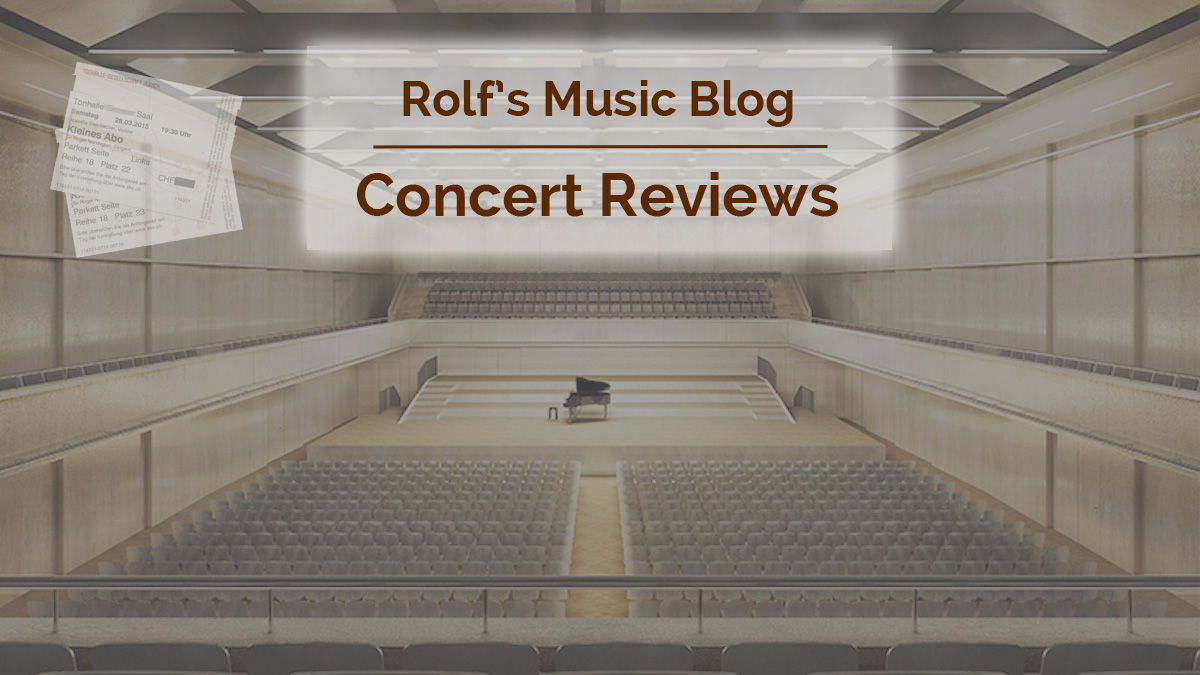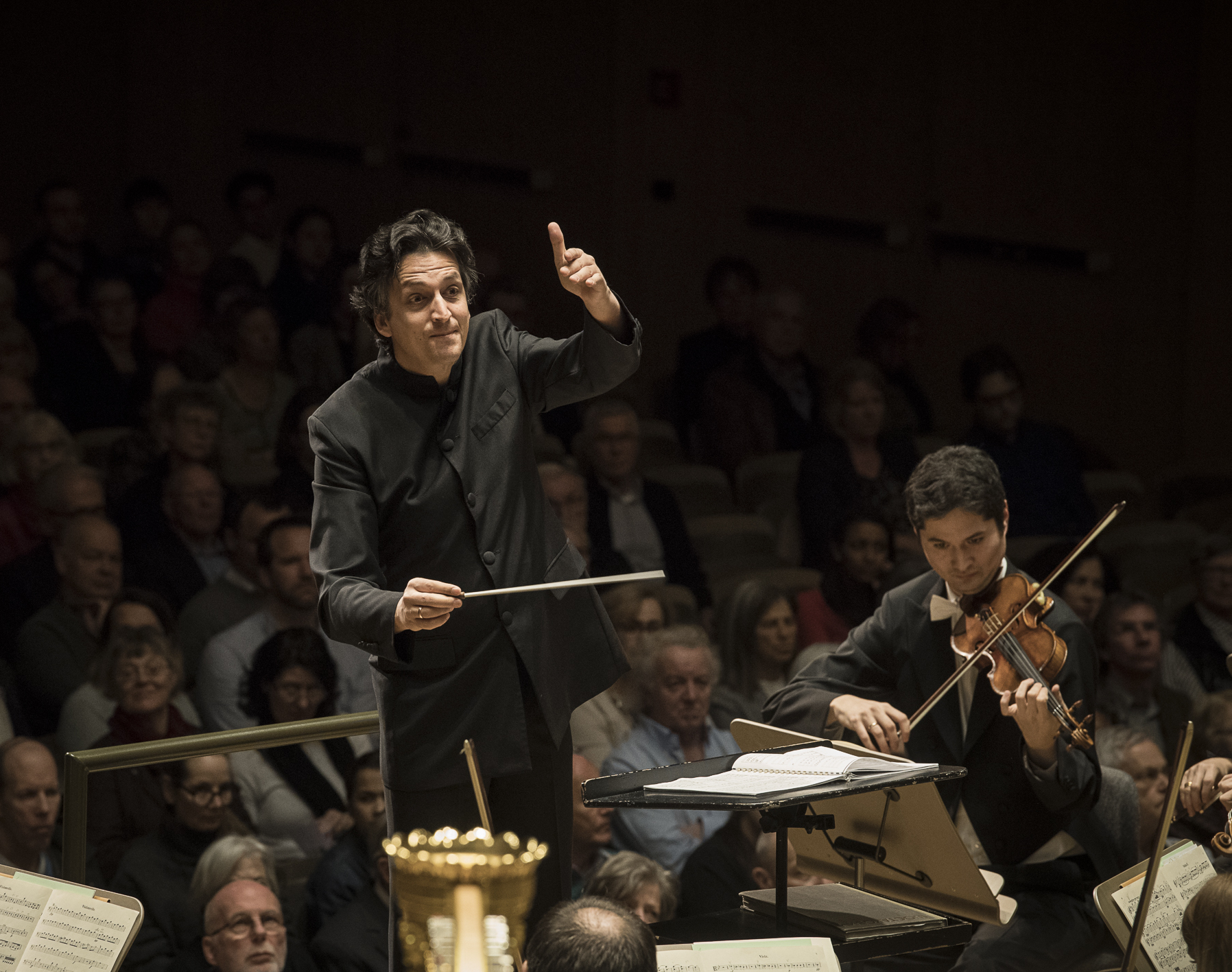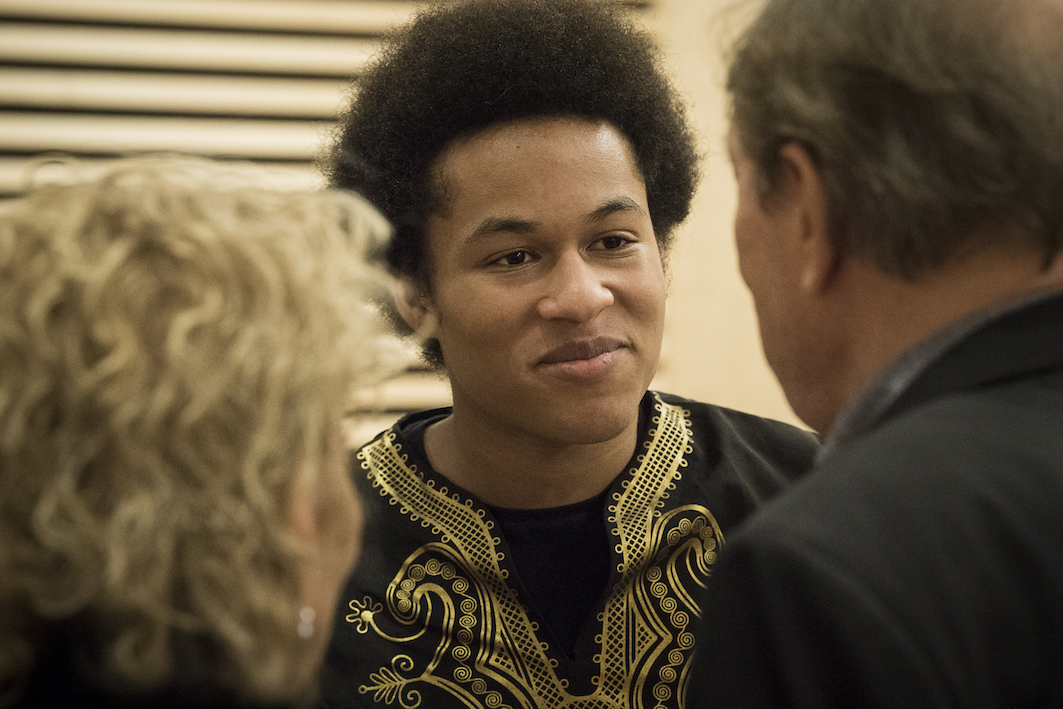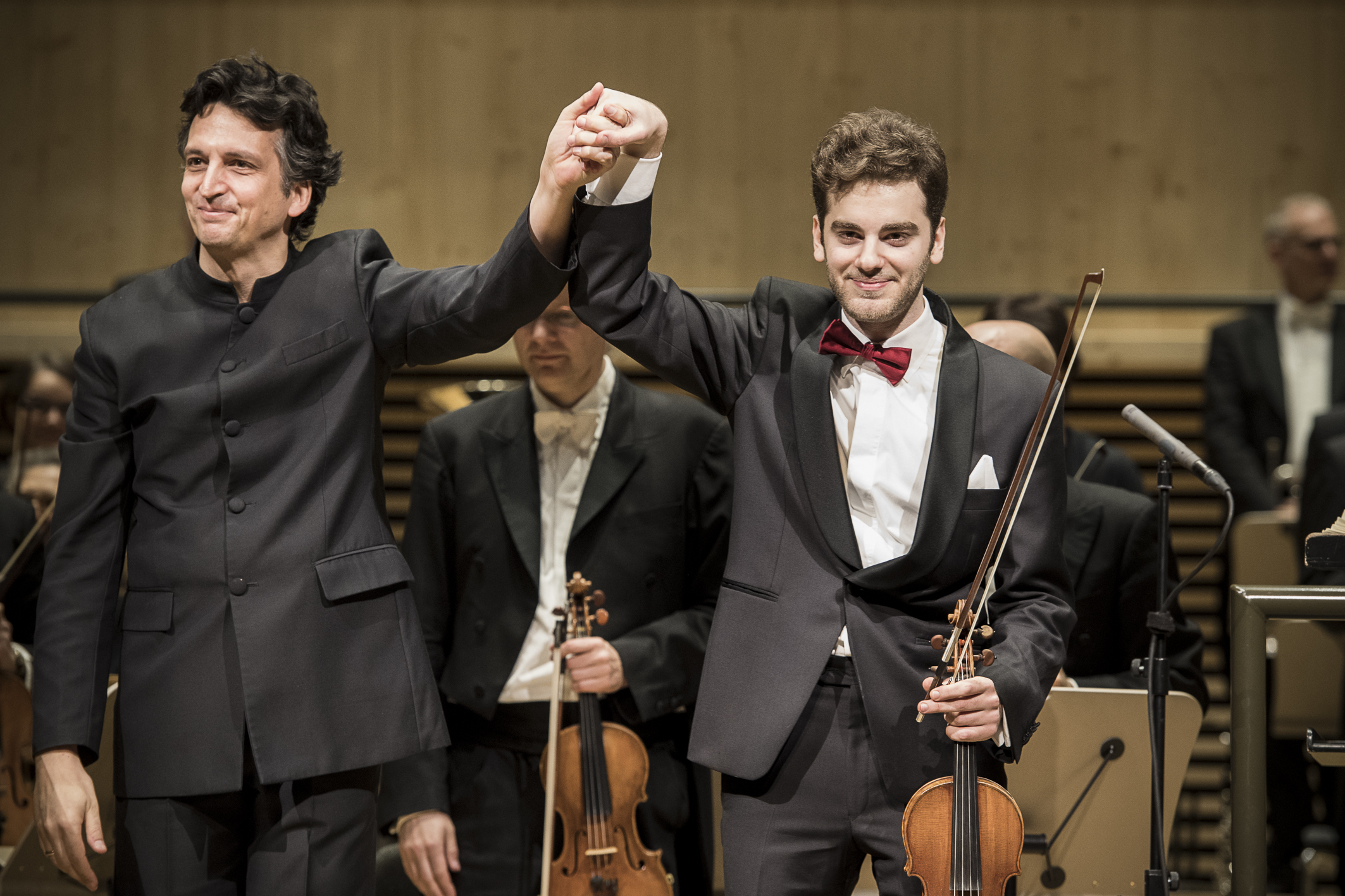Kanneh-Mason, Tjeknavorian, Sanderling / Tonhalle Orchestra Zurich
Dvořák / Shostakovich / Brahms
Tonhalle Maag, Zurich, 2018-03-14

2018-03-22 — Original posting
2018-11-05 — Minor amendment (reference for second encore)
Neue Ansätze der kommenden Generation? Sheku Kanneh-Mason und Emmanuel Tjeknavorian im Zürcher Orpheum-Konzert — Zusammenfassung
Mit seinen 19 Jahren präsentierte Sheku Kanneh-Mason bereits eine bemerkenswert eigenständige Interpretation des ersten Cellokonzerts von Schostakowitsch—eine Aufführung, die begreifen machte, warum seine Debut-CD mit diesem Konzert in England in die Charts aufgestiegen ist!
Auch der 23-jähjrige, österreichische Geiger Emmanuel Tjeknavorian bewies beim Brahms-Violinkonzert bemerkenswertes technisches Potenzial, auch wenn sich seine Interpretation noch nicht im gleichen Maße “gesetzt” hat, wie diejenige Kanneh-Masons.
In diesem Konzert der Orpheum-Stiftung zur Förderung junger Solisten stand Michael Sanderling am Pult des Tonhalle-Orchesters. Er eröffnete den Abend mit der Karneval-Ouverture, op.92 von Antonín Dvořák.
Table of Contents
Introduction
This was the first concert organized by the “Orpheum-Stiftung zur Förderung junger Solisten” (Orpheum Foundation for the Support of Young Artists) in 2018. And, as in earlier instances, the concert—now in the Tonhalle Maag—presented two young, promising artists. For these, the opportunity to perform a concerto in a symphonic concert can be instrumental in the successful launching of a personal career.
Tonhalle Orchestra, Michael Sanderling
For this concert, the Tonhalle Orchestra Zurich (see also Wikipedia) played under the direction of Michael Sanderling (*1967 in Berlin), son of the well-known conductor Kurt Sanderling (1912 – 2011). Michael Sanderling started off as a cellist. He was solo cellist with the Leipziger Gewandhaus Orchester 1987 – 1992. From 1994 to 2006 Michael Sanderling was guest solo cellist with the Berlin Radio Symphony Orchestra. In 2000, he launched a second career as conductor. Since 2011 he is chief conductor with the Dresden Philharmonic. In parallel to this position, Michael Sanderling has been guest conductor with various orchestras in Germany and Japan, as well as with the Tonhalle Orchestra.
Concert & Review
Dvořák: Carnival Overture, op.92, B.169
Antonín Dvořák (1841 – 1904) composed his Carnival Overture, op.92 (Karneval, koncertní ouvertura) in 1891. This is one of three concert overtures not linked to stage works. It is meant to open a symphonic concert. And it is excellent at that.
The Performance
Right from the first bar, this overture proved a brilliant, enthralling, highly virtuosic orchestral showpiece. The orchestra was obviously in excellent shape, with a masterful performance. Michael Sanderling conducted with light, but accurate movements. He used the right hand with the baton to control tempo, rhythm and coordination (especially in fast segments), while the left mostly shaped phrases, controlled the dynamics. In melodic, less rhythmic segments, he also often used the left hand alone.
The orchestra’s articulation was clear, precise, even sporty, up to the strong, poignant, even hard beats of the timpani. The melancholic atmosphere in the more elegiac, but also serene middle part undeniable felt like Dvořák. The music doesn’t stay in serenity for long; expectation sets in, the tone turns more dramatic, tries being joyful, vivid. Subsequently, several sudden changes in atmosphere appear to anticipate the course of action in an opera. Just as it is typical for stage overtures, even though there is no stage work attached. It ended boisterously, in excellent mood!
It was a perfect start for the concert, both in terms of performance, but also in terms of getting the listener’s ear and mind away from the hassles and noises of daily life. This enables the audience to focus on the core pieces of the concert that were to follow. Why not open every orchestral concert with an overture?
Shostakovich: Cello Concerto No.1 in E♭ major, op.107
Dmitri Shostakovich (1906 – 1975) composed his Cello Concerto No.1 in E♭ major, op.107 in 1959, for his friend Mstislav Rostropovich (1927 – 2007). Rostropovich premiered the concerto in the same year, under Yevgeny Mravinsky (1903 – 1988) conducting the Leningrad Philharmonic Orchestra. He took only four days to memorize it. Within two days of the premiere, Rostropovich also made the first recording of the composition, with Aleksandr Gauk (1893 – 1963) conducting the Moscow Philharmonic Orchestra. The work features four movements:
- Allegretto
- Moderato
- Cadenza –
- Allegro con moto
The third movement is “just” an extended solo cadenza.
The Artist: Sheku Kanneh-Mason
Sheku Kanneh-Mason (*1999, see also Wikipedia) grew up in Nottingham, together with six siblings. He began playing the cello at age 6, and at age 9, he already won his first prizes. Sheku completed his education at the Royal Academy of Music in London, later took several master classes with artists such as Raphael Wallfisch (*1953) and Julian Lloyd Webber (*1951). In 2015, he and his siblings celebrated successes on TV, and together with his sister Isata (*1996, piano) and his brother Braimah (*1997, violin), he founded the Kanneh-Mason Piano Trio.
Sheku Kanneh-Mason’s career is rapidly taking off. At his young age, he has already published his debut album, touted as “the biggest-selling British debut of the year to date”. This debut album features Shostakovich’s Cello Concerto No.1, allegedly one of the most difficult concertos for cello in the entire literature, as well as a range of smaller works, see below. Sheku Kanneh-Mason played a cello from 1610 by Antonius and Hieronymus Amati.
The Performance
The difficulties with this concerto go beyond technical aspects such as virtuosity, dexterity / agility, intonation: maybe more importantly, it’s in the aspect of “Rostropovich’s shadow”. Numerous times, the dedicatee of the concerto has presented this composition in concert and in recordings. Besides the audio recordings, several of his concert performances have been recorded and are now available as video. Needless to say that these are reference recordings, and whoever has seen one of these videos or listened to Rostropovich’s recordings will have them burned into his/her memory, no doubt.
This confronts the artist with the question whether these documents represent the sole, the only and universally valid view onto this work. In other words: how far from this “standard” is one allowed (or maybe invited) to deviate from this single view, this singular interpretation. People typically assume that a concert performance is authentic, i.e., represents the composer’s ideas. However, there is no general rule that defines what really is in the scope of authenticity.
I. Allegretto
In his interpretation, Mstislav Rostropovich seemed to expose, to focus on the motoric, the mechanical aspects. Already at the very beginning, he is poignantly percussive, earnest, if not grimly determined.
Sheku Kanneh-Mason takes an entirely different approach. His beginning seemed restrained, almost introverted. Only later, when his part moved into higher regions, his playing started to open up, turned almost playful, untroubled. His articulation was accurate, poignant, but not excessively aggressive, barely ever percussive. Despite his “mellow touch”, though, the mechanical aspects in Shostakovich’s music still transpired through his playing. Also, Sheku’s playing was rhythmically firm, with good intonation. I liked the intense singing of Sheku’s Amati cello, especially in middle and high regions—wherever there was an opportunity for a cantilena.
Michael Sanderling knows the concerto from his first career as cellist. He should have been more restrictive with the orchestra, by avoiding excess volume, to allow the audience to hear and enjoy the cello part. Apart from the aspects of acoustic balance, the wind instruments and the timpani often sounded rather hard, if not coarse.
II. Moderato
In contrast, Michael Sanderling—now conducting without baton—took the Moderato pronouncedly mellow, lyrical, careful, restrained in its dynamics. Sheku Kanneh-Mason obviously was intimately familiar with the composition. His playing was calm, unexcited, never forced. He let his instrument sing intensely, forming broad dynamic arches. At all time, he kept close contact with Michael Sanderling, but at the same time lived entirely within the music. Quite obviously, he enjoyed the beautiful cantilenas. Sheku was moving safely through an emotional build-up into the heights of the dreamy worlds of flageolet, before seamlessly passing over into the Cadenza movement.
III. Cadenza –
Sheku started this movement—a single, extensive cadenza—almost dreamy, introverted, in an intimate dialog with his instrument.The cadenza features a high, lyrical double-stop passage. This is extremely demanding in the intonation; I felt that momentarily, the intonation wasn’t always perfectly clean, maybe a tad off. On the other hand, the cellist performed masterfully in the virtuosic climax.
IV. Allegro con moto
In the final movement (which follows attacca), Sheku once again appeared almost playful. Neither Shostakovich’s motoric texture, nor the occasionally rather robust orchestral accompaniment made him lose control over the tempo (e.g., accelerate inappropriately).
Conclusions, Encore
Sheku Kanneh-Mason’s performance in this demanding and mature composition was really amazing. He did not show the slightest signs of stage anxiety, his appearance was modest, friendly and inconspicuous. As an encore, he played a calm, almost meditative, 2-minute solo—a kind of Passacaglia on a 2-bar theme. It almost felt like an improvisation, even though with all the double-stop passages it probably wasn’t. In the intermission, I asked him about the composer, and he modestly responded “Oh, that’s just something I made myself!”.
I did not expect the mature performance of a cellist at the peak of his career. However, this performance was an amazing achievement nevertheless. And Sheku’s interpretation will grow over the years, for sure! Congratulations, and best of luck for the continuation of your career!
Brahms: Violin Concerto in D major, op.77
Johannes Brahms (1833 – 1897) wrote his only Violin Concerto in D major, op.77 in 1878. He dedicated the work to his friend, the violinist Joseph Joachim (1831 – 1907). The concerto has three movements:
- Allegro non troppo
- Adagio
- Allegro giocoso, ma non troppo vivace — Poco più presto
The Artist: Emmanuel Tjeknavorian
Emmanuel Tjeknavorian, an Austrian violinist with Armenian ancestors, was born 1995 in Vienna. Both his parents are musicians: his mother is a pianist, his father a conductor. He started playing the violin at age 5 and gave hist first public concert at age 7. 2004, he won a scholarship from the Vladimir Spivakov Foundation, giving him the opportunity for appearances in the Tchaikovsky Concert Hall in Moscow and in the Great Hall of the Moscow Conservatory. In 2011, he became a pupil of Gerhard Schulz, former member of the Alban Berg Quartet, at the University of Music and Performing Arts in Vienna. For updates and more information see also Wikipedia.
Clearly, his career has progressed further than that of Sheku Kanneh-Mason: he has already presented the major, popular violin concertos of the violin concert literature in competitions and in concerts, with notable conductors and orchestras. This made me curious about his performance in the Brahms concerto. Emmanuel Tjeknavorian plays a violin by Antonius Stradivarius (1644 – 1737), Cremona.
The Performance
I. Allegro non troppo
Emmanuel Tjeknavorian’s performance appeared effortless. I have no doubts about his technical mastership: the agility in his fingers / left hand, his bowing technique and rhythmic firmness are all excellent. For my taste, his vibrato was rather nervous, even though not exceedingly strong. To me, this isn’t in agreement with the character of the concerto, even more so, when considering that the dedicatee, Joseph Joachim (and the musicians in their circle / area) used vibrato very sparingly, really just as a kind of ornament.
Also, the soloist pretty much in general seemed to push forward, didn’t leave time for a lot of agogics. He did gradually prolong key and peak notes, but rarely, if ever allowed for a little bit of ritardando in the beats preceding such notes, in order to build up agogic tension. With this I don’t mean to imply that his playing was lacking tension, or ever was even just a bit boring.
Actually, this lack of agogic play wasn’t just with the soloist. I already noted this in the orchestral introduction. Michael Sanderling rarely ever seemed to allow himself (and the orchestra / audience) the time to indulge in melodic / musical climaxes.
Sound, Balance, Cadenza
Emmanuel Tjeknavorian’s Stradivari violin sounded bright and clear, had no problem projecting across the hall. Still, Michael Sanderling should occasionally have reduced the volume in the orchestra. Luckily, the soloist did not try pushing the volume in order to compete with the orchestra—this woulod have altered the character of the music.
Tjeknavorian mastered the cadenza—the standard cadenza by Joseph Joachim—really well. He even applied rubato, but still / also here, he focused on the overall musical flow, the move forward. My personal preference would have been to leave more time for local emphasis, for agogics, especially around key notes.
Also, in the cadenza, I noted a certain tendency for the intonation to be a tad (too) high. The cadenza was followed by a short period of calm, pure serenity. Of course, the youthful push forward returned in the final bars.
II. Adagio
Here now, the soloist appeared more lyrical, more indulging, allowing for more agogic play than the oboe in the introduction. Actually, the tempo occasionally seemed a tad fast (e.g., around bar 90), giving the impression of a slight unrest. This wasn’t just the oboe, rather the orchestra in general: does Michael Sanderling lack the calm for this movement? This was reinforced by Tjeknavorian’s prominent, nervous vibrato.
III. Allegro giocoso, ma non troppo vivace — Poco più presto
Again, there was this push forward, especially in the solo part. I would not say the movement was rushed / hurried—but to me, there was an excess in unrest, maybe a lack in playfulness (after all, this wasn’t Brahms in his 20’s!). And also here, there was an occasional tendency for the soloist to be a tad high in the intonation. Definitely, I found the Coda (bars 267ff.) too fast, pushed for tempo.
Conclusions, Encore
In his appearance, Emmanuel Tjeknavorian appeared very self-confident, didn’t show any sign of nervousness. I was somewhat irritated by the fact that through most of the concerto, he appeared to play with closed eyes, for himself, didn’t seem to seek visual contact with Michael Sanderling.
However, tempo and agility / virtuosity impressed the audience, which applauded strongly. Also Emmanuel Tjeknavorian gave an encore. As Brahms hasn’t composed for solo violin, the soloist allowed himself an adaptation of Brahms’ famous Lullaby “Guten Abend, gut’ Nacht“. Brahms composed this 1867 – 1868, as No.4 of his 5 Lieder (Songs), op.49 most famous melody, which he played with a repeat, shifted up by an octave. Here only, at last, Tjeknavorian demonstrated simplicity in expression, natural, plain, unpretentious playing.
Sheku Kanneh-Mason’s Debut CD, “Inspiration”:
As a result of the enthusiastic response to his public appearances, Sheku Kanneh-Mason had the opportunity to produce his first CD recording. He did this in cooperation with the City of Birmingham Symphony Orchestra under the direction of its music director (since 2016), Mirga Gražinytė-Tyla (*1986).
Featured Work: Shostakovich’s Cello Concerto No.1
The core of the CD is Shostakovich’s Cello Concerto No.1 in E♭ major, op.107, which Sheku also played in the concert in Zurich.
As one would expect, Sheku’s interpretation on the CD does not deviate substantially from his concert performance in Zurich, but of course, sound technicians would fix / prevent any balance issues and ensure the solo is not covered by the orchestra. And of course, any mishap during the recording would be corrected through using multiple takes. For all I can tell, in terms of a recording technique, the CD is as good as expected, Sheku’s cooperation with Mirga Gražinytė-Tyla and the orchestra appears flawless, the orchestra leaves very little, if anything to wish for (I did not scrutinize the recording, though). And, as this is a studio recording, there is of course no noise of other interference from an audience.
Other works on the CD
Grouped around this are a set of smaller works, from classical to arrangements, to pieces and arrangements of music by popular artists, such as Leonard Cohen (1934 – 2016), and Bob Marley (1945 – 1981). I don’t feel qualified to comment on music outside the classical genre, but I have thrown in a few comments (also based on the information in the CD booklet) below the track listing for the CD.
Sheku’s Wikipedia entry quotes a BBC News report from 2018-02-02, stating that the album Inspiration was “the biggest-selling British debut of the year to date, entering the UK Albums Chart at number 18, had become number one on the UK classical albums chart, and had achieved 2.5 million streamings on Spotify.”
Shostakovich: Cello Concerto No.1 in E♭ major, op.107
& Other works
Sheku Kanneh-Mason, Mirga Gražinytė-Tyla, City of Birmingham Symphony Orchestra
CBSO Cellos, Guy Johnston, cello
Decca 483 2948 (CD, stereo); ℗ / © 2018
Booklet: 20 pp. en/de/fr

Track List (Total Duration: 64’12”)
- Yosef Hadar (1926 – 2006): “Erev Shel Shoshanim” (Evening of Roses), transcribed by Sheku Kanneh-Mason, arr.: Tom Hodge (Duration: 3’03”)
CBSO Cellos & Sheku Kanneh-Mason, Oliver James - Camille Saint-Saëns (1835 – 1921): from “Le carnaval des animaux“, R.125 — No.13. “Le cygne” (The Swan), arr.: Tom Hodge (Duration: 2’35”)
CBSO Cellos & Sheku Kanneh-Mason, Katherine Thomas - Pablo Casals (1876 – 1973): “El cant dels ocells“ (“The Song of the Birds”, Duration: 2’58”)
CBSO Cellos & Sheku Kanneh-Mason - Dmitri Shostakovich (1906 – 1975): From “The Gadfly Suite”, op.97a: 10. Nocturne, arr.: Levon Atovmyan (Duration: 5’05”)
Sheku Kanneh-Mason, Mirga Gražinytė-Tyla, City of Birmingham Symphony Orchestra - Dmitri Shostakovich (1906 – 1975): Cello Concerto No.1 in E♭ major, op.107 (total duration: 31’25”)
Sheku Kanneh-Mason, Mirga Gražinytė-Tyla, City of Birmingham Symphony Orchestra- Allegretto (Duration: 6’39”)
- Moderato (Duration: 12’59”)
- Cadenza (Duration: 6’52”)
- Allegro con moto (Duration: 4’57”)
- Jacques Offenbach (1819 – 1880): From “Harmonies des bois“, op.76: 2. “Les Larmes de Jacqueline“ (Jacqueline’s Tears), arr.: Werner Thomas-Mifune (Duration: 7’11”)
Sheku Kanneh-Mason, Mirga Gražinytė-Tyla, City of Birmingham Symphony Orchestra - Pablo Casals (1876 – 1973): Sardana (Duration: 6’03”)
CBSO Cellos & Sheku Kanneh-Mason, Guy Johnston - Bob Marley (1945 – 1973): “No Woman, no Cry”, arr.: Sheku Kanneh-Mason (Duration: 2’29”)
Sheku Kanneh-Mason - Leonard Cohen (1934 – 2016, see also Wikipedia): “Hallelujah”, arr.: Tom Hodge (Duration: 3’30”)
Sheku Kanneh-Mason, Didier Osindero, Alinka Rowe & Yong Jun Lee
Remarks on Selected Tracks
With this CD, Sheku Kanneh-Mason pays tribute to the artists, composers, etc. that inspired him in his career so far:
- “Erev Shel Shoshanim“ is a “heritage” from Sheku’s participation in a Klezmer band during his school years
- “The Swan” was arranged by Tom Hodge, who also arranged other pieces on the CD. Clearly not Saint-Saëns’ original, but with added voices, etc.
- Casals’ “El cant dels ocells” doesn’t need commenting—a beautiful piece, widely known, and a popular encore for cellists
- “Les Larmes de Jacqueline” is a tribute to Jacqueline Du Pré (1945 – 1987), one of the artists who (besides Pablo Casals and Mstislav Rostropovich) inspired Sheku Kanneh-Mason
- Bob Marley and Leonard Cohen are musicians that his parents frequently listened to in the car—really nice, pleasing, meditative, pensive music
The non-classical pieces aren’t exactly my speciality, and I’m also not a particular friend of “soft” arrangements, such as with “The Swan”. However, I have indeed listened to all tracks multiple times, and I must say that even music “purists” (such as myself) who never listen to non-classical music should give this CD a listen. This assumes that they are interested in the Shostakovich, of course—but that concerto is nothing to be scared about, at all. Don’t be afraid: there is no need to turn down the volume in expectation of heavy percussion noise etc.: the loudest piece on the CD is the Shostakovich concerto, all other pieces are essentially lyrical—from elegiac to dreamy and meditative. Plus: percussion is only heard when the full CBSO is involved!
Besides the obvious, the Shostakovich concerto, I quite like the CD. Even though it may not fall into my core interests: as long as Sheku can motivate youth to listen into music other than Pop / Rock, I couldn’t mind less! Give it a go!
Addendum
For the same concert, I have also written a (shorter) review in German for Bachtrack.com. This posting is not a translation of the Bachtrack review, the rights of which remain with Bachtrack.com. I created the German review using a subset of the notes taken during this concert. I wanted to enable my non-German speaking readers to read about my concert experience as well. Therefore, I have taken my original notes as a loose basis for this separate posting. I’m including additional material that is not present in the Bachtrack review.












